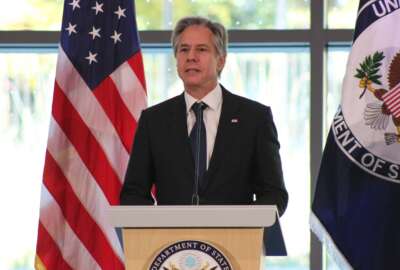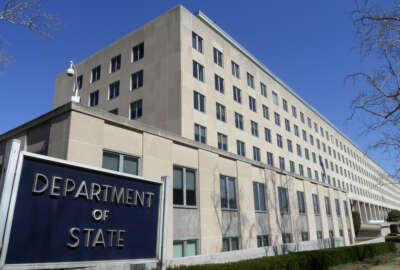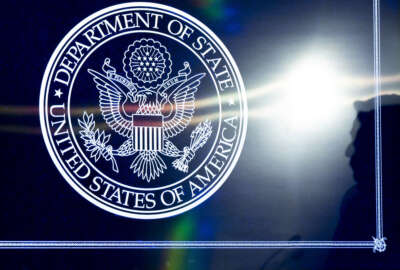State Dept sees record hiring, but seeks higher budgets through 2030 to fully replenish ranks
The State Department is bringing in a record volume of new hires, but is calling on lawmakers for increased budgets through the end of the decade to fully replenish...
The State Department is bringing in a record volume of new hires, but is calling on lawmakers for increased budgets through the end of the decade to fully replenish its ranks.
Richard Verma, deputy secretary of state for management and resources, said last Thursday that the department saw about a 7% increase in its budget for FY 2022, and saw another 7% spending increase in FY 2023.
Verma said those funding increases allowed the department to recruit and grow its workforce “in a way that we haven’t done for many years.”
However, Verma said the department would need to see about an annual 7% increase in its budget through FY 2030, just to get the department back to a baseline level of staffing and “run the department at all cylinders.”
“The State Department has really been chronically underfunded for several decades, so it’s not a new issue. And as a result, we do have a staffing gap,” Verma said at the Professional Services Council’s Development Conference in Arlington, Virginia.
This year, given its recent budget windfall, the department brought in its largest-ever classes for Foreign Service and civil service recruits.
“The quality of the class is the highest that we’ve ever had. It is the most diverse that we’ve ever had, coming from all backgrounds, all ages, all kinds of expertise,” Verma said. “People want to be a part of this institution. They love the mission of the State Department.”
The department, however, will need to sustain those record hiring efforts to operate at its full capability. Verma said that, at any given point in the year, about 10-13% of the department’s positions remain unfilled.
“If you were a business or a company, and 13% of your workforce was not available to you, or the positions were unfilled, that would be a major problem. And it creates this incredible workload issue, because then others absorb the work that should be fulfilled by those positions,” he said.
Lawmakers, however, are unlikely to support the State Department’s request for continued budget increases.
The FY 2024 spending bill the House passed in September would cut the State Department’s current budget by about 14%.
The Senate, meanwhile, passed a spending bill that would keep the department funded at its current spending level for the rest of fiscal 2024.
Both chambers remain far apart on a comprehensive spending deal for the rest of this fiscal year.
To buy more time to reach a deal, House Speaker Mike Johnson (R-La.) unveiled a two-step continuing resolution over the weekend.
The CR would keep agencies covered under four funding bills — Agriculture-FDA, Energy and Water, Military Construction-VA, and Transportation-HUD – funded at current spending levels through Jan. 19. Funding for the remaining eight funding bills would be extended through Feb. 2.
Congress has until the end of Friday to pass a continuing resolution to avert a government shutdown.
Faster passport processing
The department’s Foreign Service Institute unveiled a new wing of its Foreign Service Institute last month, meant to accommodate training for more than 900 new Foreign Service officers brought on each year.
Verma said the department, under its diplomacy modernization agenda, is also “making a huge focus on lifelong training as well.”
To upskill its workforce, the department is investing in a “training float,” a staffing concept that allows diplomats to further develop their skills and training without the department sacrificing front-line readiness at its overseas posts.
Verma said that on any given month, the department has about 1,110 employees going through training and professional development. That includes making sure mid-career diplomats have the necessary management skills.
“We do a great job at language training, we didn’t do as good a job of management training and professional development training. And we’re doing a lot more in that category,” he said.
Verma said the department is making significant progress in meeting its diplomacy modernization agenda, but said this work is “not something you really ever stop.”
“But at some point, we’re going to call an end to this phase of it, and tell you all what we’ve achieved — do a bit of a reset and start modernizing for that next phase,” he said. “But we’ve made good progress in this last two-and-a-half years or so on the modernization front,” Verma said. “I really hope the budget keeps up. These next few weeks will be really, critical for the department.”
Verma said the State Department is also taking steps to ensure it has the workforce and resources needed to stay on top of its passport workload.
The department saw passport delays and a major backlog this summer, but has now returned to processing passport applications at a rate not seen since the start of the COVID-19 pandemic.
“We’re trying to make sure that continues through calendar year 2024,” Verma said. “We can’t necessarily just hire our way out of this issue, we’ve really got to use technology and innovation.”
Part of the challenge is about demand. About 44% of the U.S. population currently holds a passport — up from about 5% in the mid-1980s.
“That is a great development. It also presents an enormous burden on the department to continue to meet that demand,” Verma said.
The department’s Bureau of Consular Affairs grew its workforce by about 10%, as of this summer, and had candidates in the hiring pipeline that would grow its workforce by about another 10% once brought on board.
However, the hiring process for passport adjudicators is slow, because candidates need to go through a security clearance process.
Verma said the department needs to ensure it’s bringing trusted and vetted employees into its ranks, because of a “significant security and fraud element” of this work.
“I know people just want us to print and print and produce. But there are a lot of bad actors out there trying to manipulate the system. It could be for identity fraud. It could be for criminal network purposes. It could be to steal from your bank accounts,” Verma said.
“We need a team of professionals to actually hit the pause button and say, ‘Is this a valid application with the right information? Can it be trusted?’ And so, as much as we’re trying to rush through and meet the demand, we also have a very serious security responsibility,” he added.
The department is also reinvesting in its international outposts.
Verma said the department is constructing embassies, consulates, and other facilities that reflect the evolving needs of the Foreign Service.
“The buildings are greener, they are safer, they are more secure,” he said.
Verma said the Foreign Service is building its new facilities to be more “interactive with the populations in the city center,” and “not as many an hour away from the city center.”
Verma said the department is also focused on making sure its facilities across the globe are more accessible to employees with disabilities — something that wasn’t prioritized when some of its facilities, some dating back to the 1950s, were built.
“People were not thinking about accessibility. They were not thinking about ramps, they were putting in a lot of stairs. A lot of parts of our facilities are not really welcoming to folks with disabilities or other needs that they might have. So we’re working hard on that front as well,” Verma said.
Copyright © 2025 Federal News Network. All rights reserved. This website is not intended for users located within the European Economic Area.
Jory Heckman is a reporter at Federal News Network covering U.S. Postal Service, IRS, big data and technology issues.
Follow @jheckmanWFED






